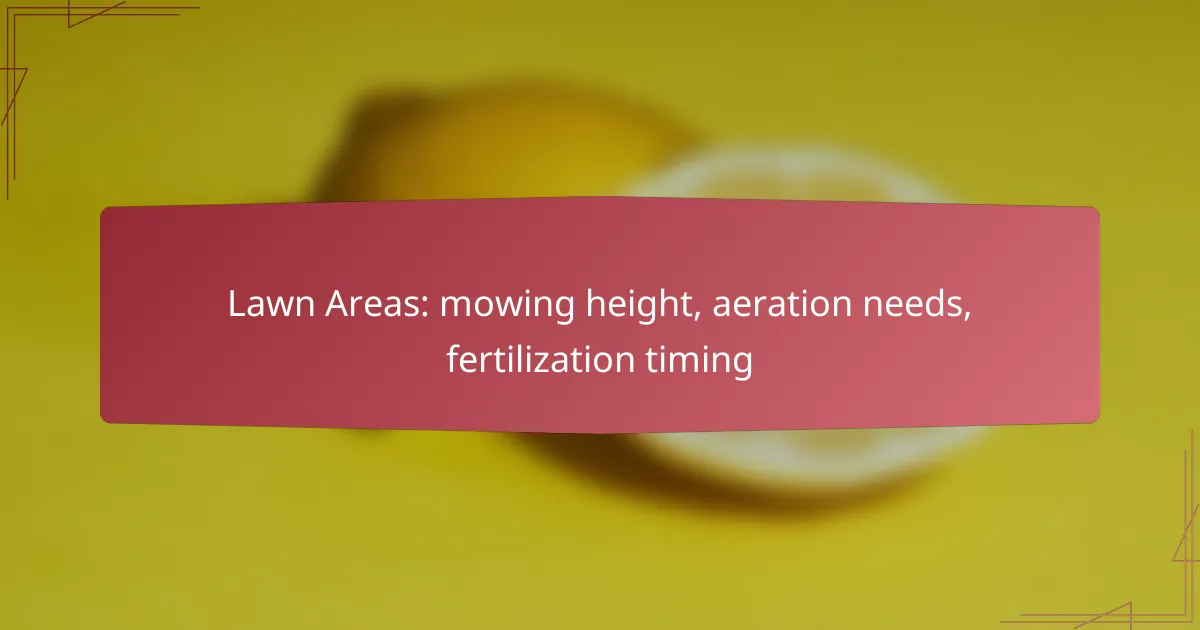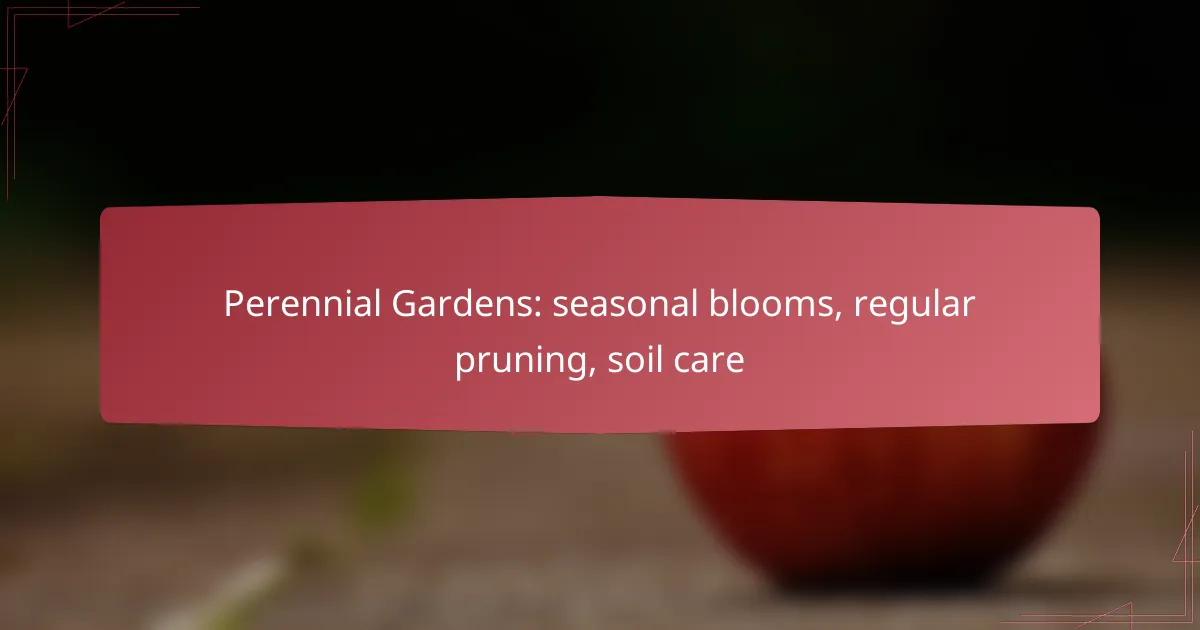Maintaining a healthy lawn requires attention to mowing height, aeration needs, and fertilization timing. In Los Angeles, the ideal mowing height ranges from 2.5 to 4 inches, which helps promote growth and conserve moisture. Aeration should be performed in spring or early fall for optimal recovery, while fertilization is best applied during these same seasons to support grass health and resilience.

What is the ideal mowing height for lawns in Los Angeles?
The ideal mowing height for lawns in Los Angeles typically ranges from 2.5 to 4 inches, depending on the type of grass. Maintaining this height promotes healthy growth, reduces weed competition, and conserves moisture in the warm climate.
Recommended height for cool-season grasses
For cool-season grasses, such as Kentucky bluegrass and fescue, the recommended mowing height is generally between 3 to 4 inches. This height helps these grasses thrive during the cooler months and provides sufficient leaf area for photosynthesis.
Regularly mowing at this height can prevent stress on the grass, especially during the warmer periods of the year when temperatures in Los Angeles can rise significantly.
Recommended height for warm-season grasses
Warm-season grasses like Bermuda and zoysia should be mowed to a height of about 1.5 to 3 inches. These grasses grow best in the heat of summer, and maintaining the lower end of this range encourages denser growth and better drought resistance.
Adjusting the mowing height according to seasonal changes can enhance the lawn’s overall health and appearance, particularly during the peak growing season.
Factors affecting mowing height
Several factors can influence the ideal mowing height for your lawn, including grass type, season, and environmental conditions. For instance, grass types that grow more vigorously may require more frequent mowing at a higher height to prevent scalping.
Additionally, during periods of drought or heat, raising the mowing height can help retain moisture and protect the grass from stress. Regularly assessing the lawn’s health and adjusting the mowing height accordingly can lead to a more resilient and attractive lawn.

When should I aerate my lawn in Southern California?
Aeration in Southern California is best performed during the spring or early fall when the grass is actively growing. This timing allows the lawn to recover quickly and benefit from improved air, water, and nutrient penetration.
Best seasons for lawn aeration
The optimal seasons for lawn aeration in Southern California are typically late spring and early fall. During these periods, temperatures are moderate, and the grass is in a growth phase, which helps it recover from the stress of aeration.
Avoid aerating during the peak summer heat or winter dormancy, as these conditions can hinder recovery and overall lawn health.
Signs that aeration is needed
Look for signs such as compacted soil, poor drainage, and thinning grass. If water puddles on the surface after rain or irrigation, it may indicate that the soil is compacted and needs aeration.
Additionally, if your lawn has bare patches or struggles to grow despite regular watering and fertilization, aeration can help improve its health and appearance.
Tools for effective aeration
Common tools for aeration include core aerators and spike aerators. Core aerators remove small plugs of soil, allowing for better air and nutrient exchange, while spike aerators create holes without removing soil, which can be less effective.
For small lawns, a manual core aerator may suffice, but larger areas may require a gas-powered aerator for efficiency. Always ensure your tools are well-maintained for optimal performance.

What is the best fertilization timing for lawns in San Diego?
The best fertilization timing for lawns in San Diego typically occurs during the spring and fall months. Applying fertilizer during these periods supports healthy growth and helps the grass recover from seasonal stress.
Optimal fertilization schedule
In San Diego, the optimal fertilization schedule generally includes applications in early spring, around March to April, and again in late summer or early fall, typically in September. This timing aligns with the growing seasons of common grass types in the region, such as Bermuda and fescue.
It is advisable to apply a slow-release fertilizer during these times to ensure a steady supply of nutrients. Regular soil testing can help determine the specific nutrient needs of your lawn, allowing for more tailored fertilization.
Types of fertilizers for local lawns
For lawns in San Diego, both synthetic and organic fertilizers can be effective. Synthetic fertilizers often provide quick nutrient availability, while organic options improve soil health over time.
Common choices include nitrogen-rich fertilizers for growth and potassium-rich options for drought resistance. Look for products labeled for local use, as they are formulated to meet the specific needs of San Diego’s climate and soil conditions.
Environmental factors influencing fertilization
Environmental factors such as temperature, rainfall, and soil type significantly influence fertilization practices in San Diego. Warmer temperatures in spring prompt earlier fertilization, while cooler fall temperatures may require adjustments to application timing.
Additionally, understanding local rainfall patterns is crucial. Fertilizing just before expected rain can enhance nutrient absorption, while dry spells may necessitate more frequent watering after application to prevent nutrient runoff.

How do mowing height and aeration affect lawn health?
Mowing height and aeration are crucial for maintaining a healthy lawn. Proper mowing height encourages robust grass growth, while regular aeration improves soil health by enhancing air and nutrient penetration.
Impact on grass growth
The height at which you mow your lawn significantly influences grass growth. Generally, keeping grass at a height of around 2.5 to 4 inches allows for deeper root systems and better drought resistance. Cutting too short can stress the grass, making it more susceptible to pests and diseases.
Aeration, which involves perforating the soil with holes, helps alleviate soil compaction and promotes healthier grass growth. This process allows roots to access more oxygen and nutrients, leading to a thicker and more resilient lawn.
Effects on soil health
Soil health is directly impacted by both mowing height and aeration practices. Maintaining taller grass can improve soil moisture retention and reduce erosion. Additionally, it encourages a diverse ecosystem of beneficial microorganisms that contribute to soil fertility.
Aeration enhances soil structure by breaking up compacted layers, allowing water and nutrients to penetrate more effectively. This practice is particularly beneficial in clay soils, which can become dense and restrict root growth. Regular aeration, ideally performed in the spring or fall, can lead to significant improvements in overall soil health.

What are the prerequisites for effective lawn care?
Effective lawn care requires understanding soil health, local climate conditions, and proper maintenance practices. These factors influence mowing height, aeration needs, and fertilization timing, ensuring a lush and healthy lawn.
Soil testing requirements
Soil testing is essential for determining nutrient levels and pH balance, which directly affect lawn health. A soil test can reveal deficiencies in nitrogen, phosphorus, and potassium, guiding your fertilization strategy.
To conduct a soil test, collect samples from various areas of your lawn, ideally 4-6 inches deep. Send these samples to a local extension service or a commercial lab for analysis. Based on the results, you can adjust your fertilization and soil amendment practices accordingly.
Understanding local climate conditions
Local climate conditions play a crucial role in lawn care, influencing growth patterns and maintenance schedules. Factors such as temperature, rainfall, and humidity can dictate when to mow, aerate, and fertilize your lawn.
For instance, warm-season grasses thrive in temperatures above 70°F (21°C) and may require different care compared to cool-season grasses, which prefer temperatures between 60°F and 75°F (15°C to 24°C). Monitoring local weather patterns can help you time your lawn care activities effectively, ensuring optimal growth and health.

How can I choose the right lawn care service in Los Angeles?
Choosing the right lawn care service in Los Angeles involves evaluating providers based on their expertise, services offered, and customer reviews. Focus on companies that understand the local climate and soil conditions to ensure your lawn receives appropriate care.
Criteria for selecting a lawn care provider
When selecting a lawn care provider, consider their experience and reputation in the Los Angeles area. Look for companies that have been in business for several years and have positive customer feedback.
Additionally, check if they offer a range of services such as mowing, fertilization, and aeration. A comprehensive service provider can better address your lawn’s specific needs throughout the year.
Licensing and insurance are also crucial. Ensure the provider is licensed to operate in California and has liability insurance to protect against potential damages during service.
Questions to ask potential services
Before hiring a lawn care service, ask about their experience with local lawns and specific treatments they recommend for the Los Angeles climate. Inquire about their fertilization schedules and aeration practices to ensure they align with your lawn’s needs.
It’s also wise to ask about their pricing structure. Request a detailed estimate and understand what services are included, as well as any potential additional costs.
Finally, inquire about their customer service policies. A reliable provider should be responsive to queries and willing to adjust services based on your feedback and lawn conditions.

What are emerging trends in lawn care for 2024?
In 2024, lawn care trends focus on sustainability and technology integration. Homeowners are increasingly adopting eco-friendly practices and smart technologies to maintain healthy lawns while minimizing environmental impact.
Eco-friendly lawn care practices
Eco-friendly lawn care practices emphasize reducing chemical usage and promoting biodiversity. Techniques such as organic fertilization, natural pest control, and native plant landscaping are gaining traction. These methods not only support a healthier ecosystem but can also reduce maintenance costs over time.
Consider implementing practices like mulching grass clippings to enrich soil and using compost instead of synthetic fertilizers. Aim for a mowing height of around 3 inches to encourage deeper root growth and improve drought resistance.
Smart lawn care technology
Smart lawn care technology includes automated systems and apps that optimize maintenance schedules and resource usage. Devices like robotic mowers and smart irrigation systems can significantly reduce labor and water waste, adapting to weather conditions and soil moisture levels.
Investing in smart sensors can help monitor lawn health and provide data-driven insights for better care. For instance, a soil moisture sensor can alert you when to water, ensuring your lawn receives just the right amount of hydration without overwatering.



